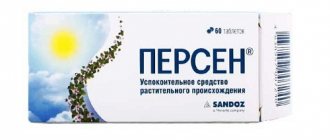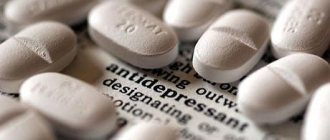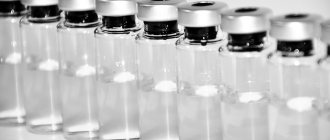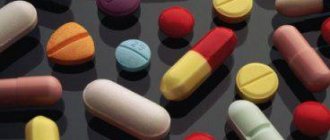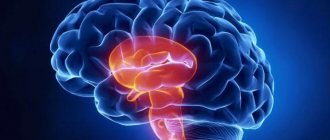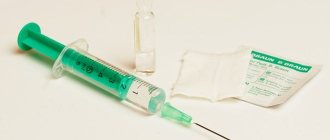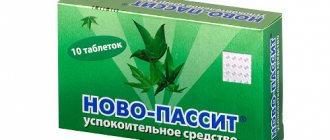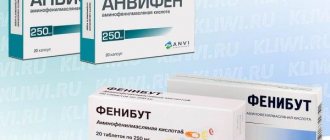Vasobral and Cavinton are used in the treatment of various diseases to improve blood flow to the brain. The effect provokes a decrease in cell adhesion. The action is also aimed at preventing problems with the formation of blood clots and promotes improved absorption of glucose specifically by nerve cells. Such actions are especially important when there is a lack of oxygen. Both drugs are stimulants of metabolic processes.
Vasobral
The active component is dihydroergocriptine - mesylate and caffeine. Available in tablet form or as a solution for oral administration. Combination vasodilating agent. Made from ergot alkaloid. Provides the effect of blocking adrenergic receptors (a1 and a2).
Provides serotonergic and dopaminergic effects, which helps reduce the aggregation of erythrocytes and platelets. The permeability parameters of the vessel walls also decrease, and the number of capillaries that function correctly increases. The general effect is to improve blood supply to the brain, ensure activation of metabolic processes, improve tissue quality (increasing resistance to hypoxia).
Caffeine increases excitation in the cerebral cortex, which in turn provokes increased physical and mental work, reduces fatigue, activates reflex excitability of the spinal cord, and has a positive effect on blood vessels and respiratory centers.
The main component is absorbed within one hour.
Application:
- For Meniere's disease.
- Disorders of the vestibular centers.
- For hypoacusis, systematic dizziness, tinnitus.
- For cerebrovascular insufficiency.
- For any consequences of circulatory disorders in the brain.
Contraindications include the inability to take it if you have an individual intolerance to the components.
Indications for use
- dihydroergocristine - 0.5;
- rutoside - 30 mg;
- esculin - 1.5 mg.
Side effects are not pronounced, among them:
- dizziness;
- feeling tired;
- swelling of the nasal mucosa;
- skin allergies.
Vertizin
International name: Cinnarizine. The medicine is available in tablets and capsules (25 and 75 mg). Price: 13 - 17.50 rubles. Take the drug if peripheral circulation is impaired immediately after meals, three times a day, with liquid.
The active substance is cinnarizine.
The drug has a vasodilator effect, directly affecting the smooth muscles of the veins; reduces blood viscosity. Indicated for use in diseases:
- thromboangiitis;
- trophic and varicose ulcers;
- coldness of the extremities.
Side effects:
- fatigue;
- drowsiness;
- tremor (in the elderly);
- dry mouth;
- skin rashes;
- allergy.
In what cases is it recommended for a patient and how the procedure is performed, you can find out from our article.
What thrombolytic drugs exist and in what cases are they prescribed? What are the medications in this group?
Cavinton
It is made on the basis of vinpocetine (from alkaloids of periwinkle extract). It is provided in the form of a concentrated solution (for injections) or tablets.
The main effect is vasodilation, increased blood supply, as well as basic brain functions. Glucose utilization and phosphodiesterase inhibition are formed. Reduces the level of platelet aggregation. With systematic use, a slight decrease in blood pressure is observed. The drug also has a direct relaxing effect on smooth muscles. Enhances the exchange of serotonin and norepinephrine, reduces the level of blood viscosity.
Indications:
- For various types of circulatory disorders in the brain.
- With transient ischemia.
- Progressive strokes.
- Neurological and mental disorders.
- Cerebrovascular insufficiency.
- Memory loss, systematic pain, motor dysfunction, dizziness.
It has acquired particular relevance in the treatment of post-traumatic encephalopathy and hypertension. It is used to eliminate vasonegative symptoms (menopause).
Nootropic drugs for the treatment of VSD
The main task of nootropic drugs is to activate the elements through which nerve cells – neurotransmitters – communicate with each other. Nootropic drugs contain substances that activate the process of biosynthesis of ribonucleic acid and protein compounds in the central nervous system. They accelerate energy processes in neurons, help reduce the number of free radicals, as a result of which they neutralize the negative effects of oxidants.
For VSD, piracetam and its derivatives (ethiracetam, isacetam, oxiracetam) have been used for many years. New generation nootropic drugs include:
- fezam;
- noopept;
- mildronate;
- phenotropil;
- noben;
- Ceraxon;
- pantocalcin;
- pantogam;
- cortexin.
The nootropic drug "Phesam" for VSD, due to the combination of cinnarizine and piracetam, the drug has an antihypoxic, vasodilating effect, improves blood circulation in the brain, and the functions of the auditory and visual analyzers. The main component of phenibut is aminophenylbutyric acid. This compound, a derivative of phenylethylamine and gamma-aminobutyric acid (GABA), plays an important role in the activity of brain neurons - it normalizes metabolism in nerve tissues and signal transmission between neurons. Phenibut plays an important role in strengthening cortico-subcortical connections. This increases the efficiency of interaction between different parts of the cerebral cortex, which is impaired in patients suffering from VSD. After taking the drug, memory improves, the speed and volume of memorized information increases, and emotional stability increases. In patients with VSD, under the influence of Phezam, the activity of mental processes is stimulated, depression, emotional excitability and irritability are reduced.
Noopept restores memory and enhances cognitive abilities, normalizes the activity of the autonomic nervous system. The drug improves mood, increases vitality, relieves stress and anxiety.
Mildronate for VSD (reviews about the drug are good) is used in the form of tablets for oral administration and injections. It has the following effect:
- increases performance;
- reduces symptoms of mental and physical stress;
- activates humoral and tissue immunity;
- has a cardioprotective effect.
Phenotropil acts on most neurotransmitter systems of the brain. When VSD has the following effect:
- activates the integrative activity of the brain;
- promotes memory consolidation;
- improves mental activity and concentration;
- facilitates learning processes;
- accelerates the transfer of information between the hemispheres of the brain;
- increases the resistance of brain tissue to toxic effects and hypoxia;
- regulates the processes of activation and inhibition of the central nervous system;
- improves mood;
- has anticonvulsant and anxiolytic activity.
Noben improves metabolic processes in the brain. It has an antioxidant effect, a psychostimulating effect and neuroprotective properties. From the first days of taking the drug Noben for VSD, antiasthenic, psychostimulating and antidepressant effects are manifested.
Due to the presence of the main active ingredient citicoline in the composition of the drug, Ceraxon has many effects:
- promotes restoration of damaged cell membranes;
- inhibits the action of phospholipases, preventing the excessive formation of free radicals;
- prevents the death of brain cells.
Pantocalcin is a nootropic and psychostimulant drug. In VSD, it has neurometabolic, neuroprotective and neurotrophic effects. Improves memory, reduces lack of initiative and difficulties that arise when performing everyday activities.
The effect of pantogam in VSD is associated with the presence of gamma-aminobutyric acid in its structure. The drug has a nootropic and anticonvulsant effect. Has the following effects:
- increases the brain’s resistance to the effects of toxic substances and hypoxia;
- stimulates anabolic processes in neurons;
- reduces motor excitability;
- combines a moderate sedative effect with a mild stimulating effect;
- activates physical and mental performance.
Neurologists prescribe Cortexin to patients for the treatment of vegetative-vascular dystonia. In case of VSD, the drug improves higher brain functions, memory and learning processes, concentration, and resistance to stress. Protects neurons from damage by various endogenous neurotoxic factors, reduces the toxic effects of psychotropic substances. Increases the survival of neurons under conditions of hypoxia and oxidative stress. Activates the metabolism of neurons, helps improve the functions of the cerebral cortex and the tone of the autonomic nervous system
Drug differences
Vasobral is considered a more popular remedy , as it has higher efficiency parameters. After a stroke, both medications can be used, but Vasobral has significant advantages, since it can help quickly restore hearing, speech, active movements of the limbs, and allows the patient to quickly adapt to social life.
Since it contains caffeine, it dilates blood vessels in the kidneys, which improves urine excretion . It affects the smooth muscles of all blood vessels, and also ensures the normal functioning of nerve cells. The main direction of action is to seriously reduce rehabilitation after a stroke, eliminate the manifestations of negative symptoms after paralysis of the limbs, stimulate the central nervous system, and improve peripheral blood circulation.
Cavinton, in turn, is able to improve blood flow in the brain, but the effect is selective, so it is used in the treatment and prevention of blood supply pathologies.
Numerous studies have failed to prove the possibility of using the drug after a stroke in rehabilitation therapy. Reduces feelings of fear, anxiety, eliminates tinnitus. It is often used in the complex treatment of high blood pressure. The active components act exclusively on receptors of blood cells and nerves. The price is three times lower than the first drug.
What is the difference between Vasobral and Cavinton?
These medications are used by neurologists in rehabilitation treatment when it is necessary to improve blood flow to the brain by reducing the aggregation of blood cells.
The drugs prevent the formation of blood clots and can increase the absorption of glucose by nervous structures. These effects are especially important when there is a lack of oxygen, which occurs due to cerebral circulatory disorders of any nature.
Both drugs are considered stimulants of metabolic processes.
Let's look at the main differences between these drugs, presented in the table.
Comparison tableCavinton Vasobral
| Main active substance | |
| Vinpocetine | Dihydroergocryptine + Caffeine |
| Origin of the active substance | |
| From alkaloids of vinca extract | From ergot alkaloids |
| Release forms | |
|
|
| Substance application points | |
| Receptors of nerve cells, blood | Vascular smooth muscle, nerve cells |
| Action | |
| Selectively improves blood flow to areas of the brain with pathological blood supply, reduces the aggregation of blood cells. Proven effect on dizziness, unsteady walking, anxiety, tinnitus | Stimulates the central nervous system, reduces the manifestations of migraines, improves peripheral circulation, eliminates trophic disorders of paralyzed limbs, and reduces the rehabilitation time of patients with cerebral strokes. |
| Country of issue | |
| Hungary | France, Germany, Italy |
Cavinton's controversial effectiveness
61 international studies since 1975 have focused on Vinpocetine. Evidence has been obtained of its effectiveness in various clinical situations. This is a decrease in short-term memory in older people, dizziness of various nature, and mental disorders of the post-stroke period.
However, 2007 follow-up reviews of these studies by international committees did not confirm the results. The drug is considered ineffective for these situations and is classified as a drug with unproven effect. For this reason, the medicine is not used in the United States.
European doctors use Vinpocetine, observing its effect after 1-2 weeks of regular use.
Begin its use with an intravenous drip once a day for up to 3 hours; after a few days, the doctor recommends further use of the drug with tablets after meals.
The main direction of use of the drug was chronic neurological diseases with impaired blood supply to the brain.
A modest result of treatment can be observed only in complex therapy of long-term use; it is difficult to assert the result of the independent action of this remedy. Vinpocetine is not used in emergency therapy due to unproven action.
The “niche” of application is limited to the rehabilitation therapy of chronic neurological conditions. Competent experts compare its effect with a placebo.
Features of the action of Vasobral
Dihydrogenated ergot alkaloids have been used after their synthesis since the late 60s of the 20th century. The predominant effect on the vascular wall with a selective vasodilating effect on the brain and limbs determined the use of Vasobral by neurologists. These are the following situations:
- Recovery period of cerebral stroke.
- Preventing migraine headaches.
- Diseases with vascular spasms of the extremities.
The medicine has a result of use that depends on the dose used. An overdose will be signaled by a heartbeat and a decrease in blood pressure, so the drug should be used under the supervision of a doctor, taking into account his advice.
A sharp change in body position from horizontal to vertical when using Vazobral can cause dizziness, weakness, and nausea due to a decrease in blood pressure (orthostatic hypotension).
The prescribed tablets of this drug or liquid to be taken by mouth should be taken in the first half of the day with meals so as not to cause sleep disturbances.
30 tab.
conclusions
Neurologists have no doubt when choosing between Vasobral and Cavinton - which is better to prescribe during the recovery period for a stroke: preference is given to the first.
The earlier the use of the medicine is started, the faster speech, hearing, and active movements of the limbs are restored, and the patient becomes able to self-care and adapt to normal life.
Taking tablets or drops for venous insufficiency improves blood flow by reducing the clumping of blood cells. The caffeine in the medicine dilates the blood vessels of the kidneys and increases urine output.
This combined action of the drug components has promise in the treatment of heart failure in some patients.
Narrowing of the vessels of the extremities of a paroxysmal type (with Raynaud's disease) or long-term existing (with atherosclerosis) becomes the reason for the use of the drug in surgical pathology.
Good effectiveness and the absence of synonyms for the composition explain the high price of Vazobral (3 times higher) compared to Cavinton in tablet form; the injection form of the latter is half the price.
Source: https://www.kliwi.ru/2017/08/chem-otlichayutsya-vazobral-i-kavinton.html
Which is better to use?
Experienced specialists believe that in any case, Vasobral is the best medicine. Ergot alkaloids have incredible benefits on vascular walls and provide a vasodilating effect. It is actively used in neurology during recovery after a stroke, as a prophylactic agent to prevent problems with blood circulation (prevention of headaches). Prescribed for vascular diseases (various types).
The presence of caffeine provides an additional effect, which provokes the possibility of using the drug for Raynaud's disease, in the treatment of heart failure, and for atherosclerosis.
Cavinton has an affordable price, which makes it relevant in the treatment of a number of mental and neurological disorders, memory disorders, speech disorders and in the complex therapy of hypertension. Prescribed for angiospastic changes in the retina, for dizziness.
Medicine and healthComment
Cinnarizine and Mexidol: which is better, can it be taken at the same time and compatibility
Today, overwork occurs in almost every person. As a result, irritability, absent-mindedness, and tinnitus may occur. It is important to know that these symptoms are associated with impaired blood circulation in the brain tissue, and such a patient needs medical advice.
Ignoring these symptoms for a long time can lead to serious complications. Cinnarizine or Mexidol are prescribed by doctors for hypoxic conditions, depending on the symptoms and diagnosis. Later in the article we will look at the two drugs in detail and figure out which is better.
General information about Cinnarizine and Mexidol
Cinnarizine is a medicine produced by a Bulgarian pharmaceutical plant. The medication consists of a synthetic vasodilator - cinnarizine, a derivative of diphenylpiperazine.
This remedy is most often used for vascular disorders of a spasmodic nature. It also has a number of analogues in the form of Stugeron, Vertizin, Tsinedil. The product is available in the form of tablets for oral administration. And it is taken only as prescribed by a doctor.
Effects of BCC on the body
Mexidol is a free radical inhibitor. The medicine is produced at a pharmaceutical plant in the Russian Federation. The medicine has antihypoxic, stress-protective, nootropic, antiepileptic and anxiolytic effects. The medicine helps improve metabolism and blood circulation.
Available in dosage forms such as tablets and solution for intramuscular and intravenous administration. Most often, patients with severe disease are prescribed injections at the beginning of therapy, and from the second or third week, treatment with tablets. For mild to moderate disease, tablets are prescribed.
Impact principle
The therapeutic pharmacological effect is due to the fact that Cinnarizine belongs to the group of calcium antagonists. Cinnarizine normalizes cerebral, peripheral and coronary circulation.
The product also helps normalize microcirculation. The medicine reduces blood viscosity and thereby protects the blood vessels of the brain from thrombus formation.
It also increases tolerance to oxygen deficiency and thereby has an antihypoxic effect.
The drug does not have a significant effect on blood pressure and heart rate, so any undesirable effect rarely occurs when taking the medication.
Mexidol slows down the oxidative degradation of lipids, which occurs under the influence of free radicals. It also increases the enzymatic activity of the antioxidant metalloenzyme, superoxide dismutase. This ensures the maintenance of optimal levels of superoxide radicals in tissues and also protects the heart during ischemic attacks.
Indications and restrictions
Cinnarizine is taken as a cerebrovascular agent for cerebral circulatory disorders that arise as a result of vasospasm, atherosclerosis, traumatic brain injury, or stroke. The medication helps reduce cerebroasthenic phenomena, headaches, and tinnitus.
Cinnarizine is recommended for migraine pain and Meniere's disease. The medication is also used to reduce the severity of symptoms of obliterating endotheritis, thromboangiitis, Raynaud's disease, and acrocyanosis.
Application of Cinnarizine
Do not take the drug in the following cases:
- in the acute phase of a stroke of hemorrhagic, cerebrovascular type;
- with severe ischemic heart disease;
- for arrhythmia.
Mexidol is used to treat diseases such as transient ischemic attack, mild traumatic brain injury, encephalopathy, vegetative-vascular dystonia, atherosclerosis, coronary heart disease, alcohol withdrawal syndrome, and intoxication with antipsychotic medications.
Mexidol is not used in case of an allergic reaction to the components of the medication, kidney or liver failure. It is also not recommended to drink it during pregnancy and breastfeeding.
Instructions for therapy and compatibility of products
The dosage of Cinnarizine is calculated as follows:
- For blood flow disorders, adults and adolescents are recommended to take 25 mg of the drug three times a day.
- For peripheral circulatory disorders, adults and children who have reached the age of twelve take 50 mg three times a day.
You should not take more than 9 tablets per day, as this will lead to an overdose and a high risk of side effects. You need to increase the dose smoothly and gradually, since sudden changes in dosage have a bad effect on health.
- For imbalances, 25 mg should be used three times a day.
- For motion sickness, take one tablet thirty minutes before the start of the trip. For long trips, take the next tablet after six hours. You should take the medicine only after eating.
As for Mexidol, it is taken one or two tablets three times a day. You should not take more than six tablets per day. The duration of therapy depends on the stage of the disease.
Most often, therapy lasts from two to six weeks of continuous use. In the case of treatment of coronary heart disease, therapy lasts one and a half to two months.
The dose of Mexidol should be increased gradually, the initial dose is one tablet (25 mg) three times a day.
Both drugs are prohibited from being divided, crushed, or chewed. Also, the medicine must be taken with still water at room temperature.
In elderly patients, coordination may be impaired during treatment, so for them the dose must be selected very carefully and adjusted during therapy.
For the drugs Mexidol and Cinnarizine, it is possible to take them together; the course of treatment and dosage in this situation is determined by the doctor. Due to the fact that the drugs act on different parts of the pathogenesis of neurological disorders, Mexidol and Cinnarizine can be taken together. With this combined treatment, the therapeutic effect occurs much faster and the therapeutic effect is much stronger.
Key differences and effectiveness
The medications are very similar in their indications, and at the same time they have different properties. Features of Mexidol are:
- reduction of oxygen deficiency in the brain;
- prevention of convulsive syndrome;
- increased tolerance to irritants and stress;
- normalization of blood flow in vessels;
- nootropic and antioxidant effects.
The active substance is usually classified as a new generation of medicines, and is often used in complex therapy. And Cinnarizine is more often used only as a vasodilator and has a narrower range of indications.
Results of using Mexidol
Therefore, these two medications are often prescribed simultaneously to achieve the desired therapeutic effect. However, any drug combinations must be agreed with the attending physician, since independent treatment can cause harm to health.
The effectiveness of a medication can only be judged based on the indications and individual sensitivity of the patient’s body. For diseases associated with vascular spasm, Cinnarizine is best suited, but for hypoxic conditions Mexidol is more often used. The choice of medicine should be made only by a specialist.
You cannot decide on your own which remedy is more suitable. Also, sometimes the doctor can replace one medication with another if an allergic reaction develops.
Side effects
Sometimes when taking Cinnarizine, the patient may notice drowsiness even during the daytime. Drowsiness is pronounced precisely at the beginning of the course, so for the first days it is better to refrain from driving a car.
Also, sometimes the patient may experience dryness in the mouth. Allergic reactions to both medications may include the development of itching, swelling, redness and swelling of the skin.
Sometimes, to eliminate side effects, it is enough to simply reduce the dose of the drug.
Interaction with other tools
Mexidol is combined with almost any drug that can also be used in the treatment of somatic diseases. As for benzodiazepines, their effects may be enhanced when taken together.
The drug has a similar effect when taken simultaneously with antidepressants, anxiolytics, anticonvulsants, and antiparkinsonian drugs.
The product also helps reduce the toxic effect of ethyl.
When taking Cinnarizine and ethyl alcohol or drugs containing alcohol simultaneously, depression of the central nervous system may occur.
A similar effect occurs when used simultaneously with antihypertensive, nootropic, and vasodilator medications. Also, you should not combine the medicine with tricyclic antidepressants, sleeping pills, and sedatives.
Reviews from doctors and patients
Among patients who took medications, reviews are mostly positive:
Tatyana Petrovna, 65 years old: “For dizziness, the doctor prescribed Cinnarizine to me. I took it for a long time, but did not notice any significant improvement in my condition. Then the doctor recommended that I take it in combination with Mexidol. Already from the second week I noticed improvements.
I’ve been taking it for one month now and I can note that headaches and dizziness are occurring less and less often. But for a therapeutic effect, the doctor said that you need to take them for a couple more months.” Pyotr Vasilyevich, 44 years old: “I have been taking Cinnarizine for several years for tinnitus.
The medication helps me very well with constant long-term use, so you shouldn’t expect improvement immediately after starting treatment. Since I started taking it, I have noticed that my headaches don't hurt as often and the ringing in my ears is getting less frequent.
The medication has never caused me any allergies or side effects. Also, this product is inexpensive, and I can purchase it monthly.”
Anna Viktorovna, 48 years old: “I started taking Mexidol in combination with Cinnarizine after a traumatic brain injury that occurred as a result of an accident.
After the incident, constant headaches began and tinnitus appeared. It was for these symptoms that the doctor recommended complex treatment to me.
Indeed, as soon as I started taking medications, my condition improved noticeably, but there is still a long way to go until complete recovery. It’s important to know that you can’t take these medications without a doctor’s recommendation, so I don’t recommend that anyone take them on their own for headaches.”
Tatyana Anatolyevna, 63 years old: “I take Cinnarizine and Mexidol in courses in the spring and autumn, since it is during this period that I experience exacerbations of coronary heart disease. With timely treatment, I manage to avoid exacerbation of the disease.
The doctor also explained to me that these medications should be taken over a long course, and not as continuous therapy.” Combination treatment always has a stronger effect than monotherapy. Mexidol and Cinnarizine act on different parts of the pathogenesis of the same disease, and therefore they are often prescribed in combination for the treatment of vascular diseases.
Mexidol relieves hypoxia, and Cinnarizine eliminates spasm. Only a specialist can prescribe these medications.
When taken together, the doctor must adjust the dosage, and treatment should begin with the minimum dose.
Also, medications are combined if one drug does not give a positive therapeutic result or has low effectiveness.
And if you have any allergic reaction or unpleasant symptom, you must contact your doctor so that he can suggest the most suitable analogue.
Source: https://Pilyule.com/sravnenie/cinnarizin-i-meksidol/
Comparison of side effects of Vasobral and Phenotropil
Side effects or adverse events are any adverse medical event that occurs in a subject after administration of a drug.
Vasobral's side effects are almost the same as Phenotropil's. They both have few side effects. This implies that the frequency of their occurrence is low, that is, the indicator of how many cases of an undesirable effect of treatment are possible and registered is low. The undesirable effect on the body, the strength of influence and the toxic effect of Vazobral are similar to Phenotropil: how quickly the body recovers after taking it and whether it recovers at all.
Contraindications and side effects
| Admission restrictions | Negative effects |
| Pregnancy | Rapid decrease in pressure |
| Hypersensitivity to the components of the drug | Insomnia |
| Breast-feeding | Pain in the epigastric region |
| Children under 18 years of age | Headache |
| Painful palpitations | |
| Dizziness |
Comparison of safety of Vasobral and Phenotropil
The safety of a drug includes many factors.
At the same time, in Vazobral it is quite similar to Phenotropil. It is important where the drug is metabolized: drugs are excreted from the body either unchanged or in the form of products of their biochemical transformations. Metabolism occurs spontaneously, but most often involves major organs such as the liver, kidneys, lungs, skin, brain and others. When assessing the metabolism of Vasobral, as well as Phenotropil, we look at which organ is the metabolizing organ and how critical the effect on it is.
The risk-benefit ratio is when the prescription of a drug is undesirable, but justified under certain conditions and circumstances, with the obligatory observance of caution in use. At the same time, Vasobral does not have any risks when used, just like Phenotropil.
Also, when calculating safety, it is taken into account whether only allergic reactions occur or possible dysfunction of the main organs. In other matters, as well as the reversibility of the consequences of using Vasobral and Phenotropil.

